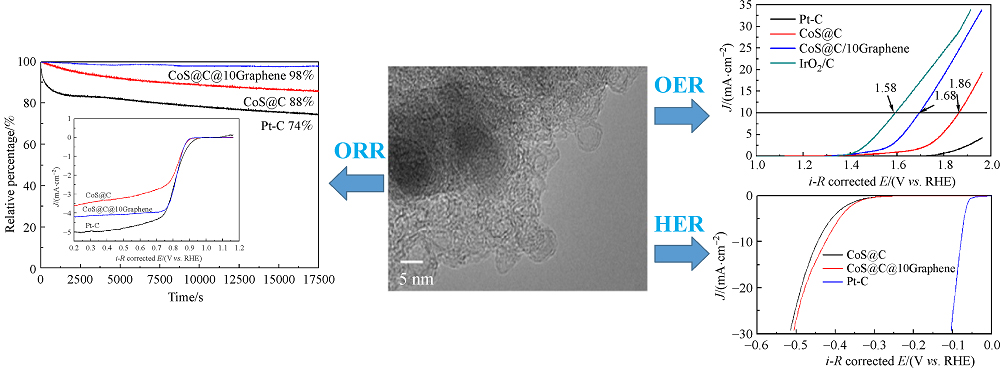The XPS element survey spectra of CoS@C/10Graphene and CoS@C (Fig. 3(a)) show the binding energy peaks at 165, 284, 400, 530 and 778 eV, which can be assigned to S 2p, C 1s, N 1s, O 1s and Co 2p, respectively [
48,
49]. The high-resolution XPS spectra of C 1s (Fig. 3(b)) of both samples exhibits a strong peak with binding energy at 284.6 eV, which arises from the formation of sp
2 hybridized graphitic structure [
49]. This C 1s peak may be deconvoluted into several peaks located at 284.9, 285.9 and 288.8 eV that are due to C=C, C–S and C–N, respectively. The Co 2p (Fig. 3(c)) spectra of both samples display not only the spin-orbit doublets at 782.8 and 798.3 eV, indicating the presence of Co
2+ oxidation state in both composites, but also another doublets at 778.8 and 793.5 eV, implying the existence of Co
3+ oxidation state. Therefore, both samples possess mixed oxidation states of Co
2+ and Co
3+, but the Co 2p is dominated with Co
3+ state in CoS@C/10Graphene while it is mainly presented as Co
2+ states in CoS@C. In the S 2p spectra of both samples (Fig. 3(d)), the peaks at 168.5 and 169.7 eV indicate that CoS compound was formed during the sulfurization process. The two peaks at 161.4 and 162.5 eV were due to the spin-orbit coupling of metal sulfide. No peak at 163.5 eV was observed, suggesting negligible or little S has been covalently bonded to the porous carbon or graphene in the as-synthesized composites. These results are in agreement with previously reported results [
37]. N 1s spectra (Fig. 3(e)) for both samples can be deconvoluted into several peaks: the two peaks at 397.8 and 401.8 eV can be attributed to the pyridinic N species and quaternary N species, respectively [
49,
50]. The peak at 400.1 eV corresponds to pyrrolic N species, which is also consistent with previous report [
37].










